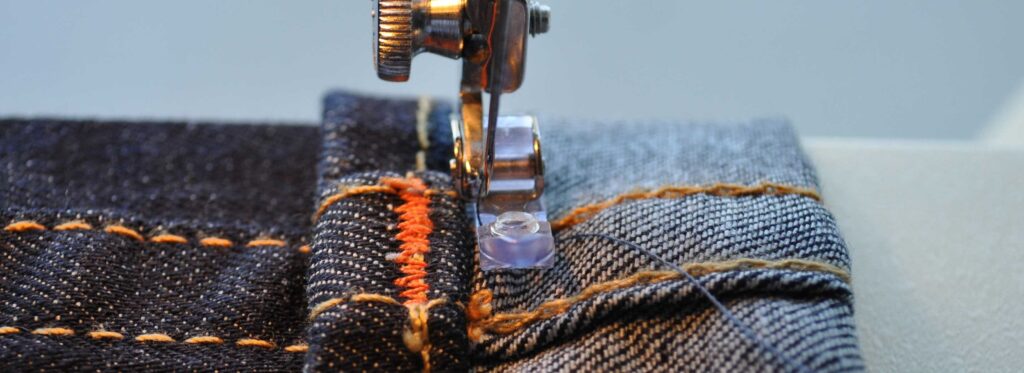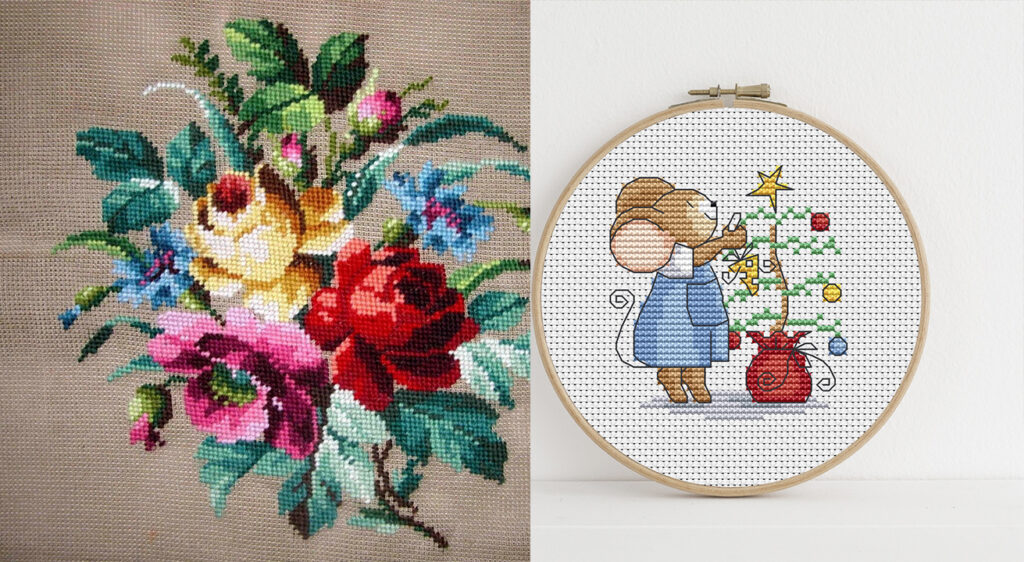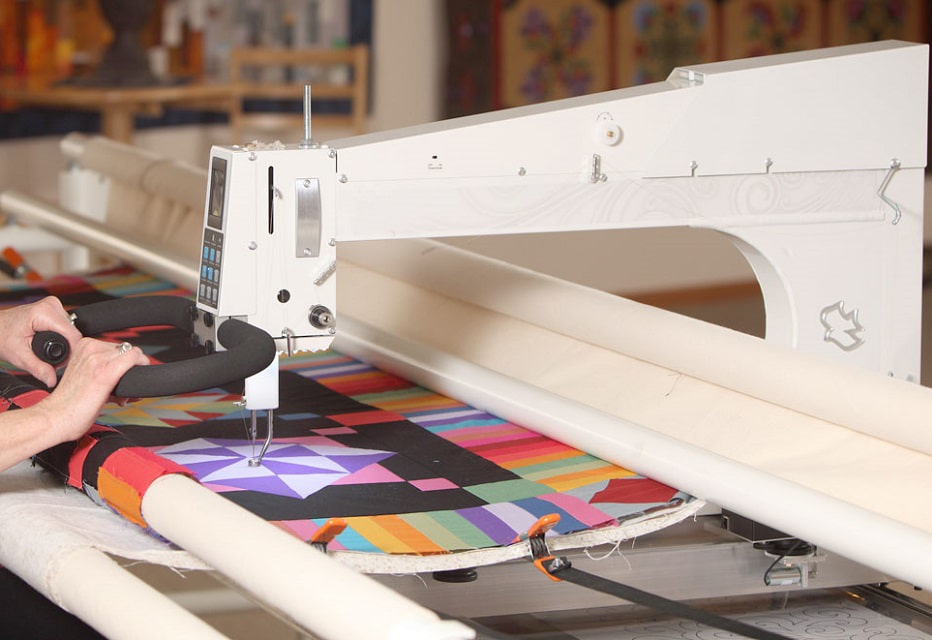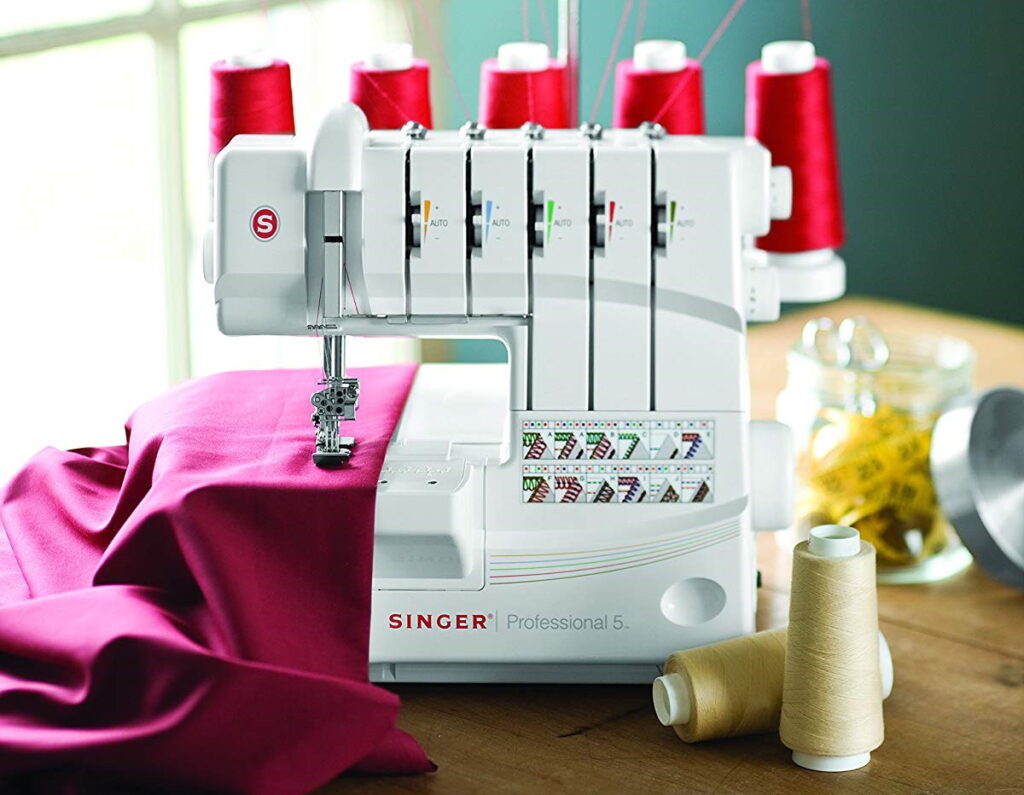An industrial sewing machine might be overwhelming to think about but the truth is they’re perfect for anyone who regularly sews using a wide variety of materials. You don’t have to be an industrial-sized clothing manufacturer to get a lot of use out of the best industrial sewing machine. The truth is that they’re a great investment for a dressmaker, tailor, or serious hobbyist to use at home. They’re fast, accurate, and incredibly dependable and they can stand up to a large volume of work.
Whether you make dresses from home or have a small tailoring business, it’s important to figure out which of these machines will not only make your work more efficient but will also end up being a great investment in the long run. We looked at the size of each machine so you know how much space it will require as well as stitches per minute to show you just how fast these machines are. We also considered maximum stitch length so you know what applications the machine is best for and warranty information, something you should always pay close attention to when making a major purchase.
To put together this buying guide, we spent hours pouring over comments, reviews, and instruction manuals written by experts, manufacturers, and people just you who use these machines every day. The first thing you’ll see is a table where you can see all of our top picks compared side by side. After the table is our in-depth reviews for each product followed by a detailed buying guide to help you figure out which is the best industrial sewing machine for you.
More features: 110V, quiet servo motor
The JUKI DDL-8700 is a great choice for tailors or anyone who frequently sews using large pieces of materials because the distance from the machine arm to the needle is wide enough to handle light and medium weight materials. It features single-needle operation and is designed for use with light to medium weight fabrics.
This machine has high-speed stitching performance of 5,500 stitches per minute yet it still operates with low vibration and low noise which makes it really comfortable for the user and perfect for home use. The intuitive design is easy to use and exceptionally reliable and delivers even, consistent results.
It comes as a complete unit that includes the machine head, table, stand, and motor plus it has a sewing light and drawer for added convenience and is covered by a generous 5-year limited warranty.
One downside to this machine is that it’s not meant for use with leather or heavier materials. Also, while it’s generally quiet and operates with low vibration, this can be an issue if the machine is set up on an uneven surface. Because this is industrial equipment, it’s not unusual for there to be minor blemishes on the table.
More features: triple feed, 14 mm foot lift, adjustable height of the walking motion, servo motor
If you’re looking for a machine that’s a top pick by professionals because of its performance and reliability, take a look at the Consew 206RB-5. It’s suitable for light to heavy weight materials including vinyl, upholstery, canvas, and is the best choice for leather.
This machine features a walking foot triple feed for even feeding and an easily adjustable high foot lift to handle thick, bulky materials. It also has a locking stitch regulator that prevents changes in stitch length that can occur from vibration and a large bobbin that can be changed without having to remove the material being sewn.
That’s not all. The safety clutch has a simple push-button reengagement and adjustable reverse stitching means that reverse stitches can be the same length as forward stitches. This is a great choice for anyone looking to sew things like umbrellas, luggage, handbags, canvas, and even auto and boat upholstery.
Everything you need to get started comes with it including a table and Servo motor although it does not come fully assembles and some users have commented that there are no clear assembly instructions included. You’ll have to do some digging to find videos online for assistance.
More features: LED lights, one pedal operation, automatic needle threader, enlarged bobbin case area
The JUKI TL-2000Qi is a great choice for home use for a lot of reasons. It performs at 1,500 stitches per minute which is the ideal speed for quilting or home decor. An aluminum die-cast arm and bed keep vibrations down and there’s an extension table included if you need a larger work area up to 23 inches. There are 9 inches of space between the needle and the arm of the machine so you can do large quilting projects with ease. It even includes a ⅕-inch quilting foot for optimal results.
This machine has an easy-to-use 1-pedal operation and features LED lights so that you can easily see the work area for increased precision. The automatic needle threader and automatic thread cutter are both really convenient, too, although some users felt both were a little too difficult to figure out and made the machine a little tricky to use.
Because this machine is constructed using aluminum die-casting, it’s extremely durable while remaining lightweight. In fact, at just under 38 pounds, this sewing machine is somewhat portable.
One thing that some users complained about is that this machine requires a fresh application of oil with every use though this was not a common complaint.
More features: automatic lubrication, 13 mm foot lift, clutch motor
For a great machine that’s budget-friendly, take a look at the Yamata FY8700. This is a great choice for thin to medium weight fabrics. It has a powerful ½ hp clutch motor and an automatic lubrication feature.
One of the best things about it the advanced noise-decreasing device which makes it a great option for home use. It’s reliable and exceptionally durable with a speed of 5,500 stitches per minute and a 13 mm foot lift.
This machine can be used with a variety of materials but note that it doesn’t have a walking foot so it’s not a good choice if you’re looking for something that’s able to do quilting though it’s ideal for handling layers of light, thin fabric with tight, straight stitches.
One downside is that this machine comes unassembled. While this in and of itself isn’t necessarily a problem, several users commented that the assembly instructions are very unclear and difficult to understand. That said, once it’s assembled, troubleshooting is pretty easy and parts and thread are relatively inexpensive. The bobbin can also be a bit tricky and has occasional problems winding.
More features: backlatching function, double-type thread tension control mechanism
The JUKI MO-6714S is a 2-needle, 4-thread overlock sewing machine that’s meant to be used with thin to medium weight fabrics, even those that are stiff or stretchy. This is a great option for anyone looking for a top-of-the-line serger sewing machine for edging, seaming, or hemming.
With a maximum speed of 7,000 stitches per minute, this machine is fast and impressive. Superior backlatching capabilities eliminate the need for bartacking and secure the chain-off thread into the seam to make sure it doesn’t come undone.
This is a complete unit that includes the machine head, table, stand, and motor as well as a sewing light and drawer. Everything comes pre-assembled and ready to sew. Because this is an industrial machine, there may be some imperfections in the table and legs but this is purely cosmetic and doesn’t affect the performance at all.
One downside is that this machine is powerful and meant for industrial use so it can be quite loud. Please note that this machine is meant for overlock stitches but the tension-release function can be disabled and the machine can be used for continuous stitching and run stitching with some modifications.
The JUKI MO-6714S is sold as a complete unit, which includes the machine head, table, stand, motor, sewing light, drawer, and all necessary components installed and ready to sew.
Now that you’ve seen our top picks for the best industrial sewing machine, let’s take a close look at the things you should keep in mind when shopping.
Which industrial sewing machine is right for you really depends on how you’re going to use it. For example, a dressmaker has different needs than someone making leather bags or car set covers. Some of these machines, like the Yamata FY8700, are suitable for thin to medium weight fabric while others, like the Consew 206RB-5, are great for heavier fabrics like leather or canvas.
While some manufacturers are very specific about the types of material their machines can be used with, that’s not always the case. A good rule of a thumb is that the presser foot should be more than 3mm higher than the thickness of the material to make sure that it can move easily under the needle.
Some industrial equipment is portable while other machines require 2 operators. That’s why it’s so important to know how you’re going to use your machine so you purchase the right model.
Here are some useful tips to keep in mind, especially when you’re first starting to use it.
These machines are pretty expensive, usually costing between $1000 to $3500. While this may sound like a hefty price, you have to think about a machine like this as an investment. If you’re going to be using it for a small business, the speed, efficiency, and quality you get from these machines will pay off in the end.
There are some specific things you should consider when deciding which machine is the right one for you.
These machines are larger than regular home sewing machines so it’s really important to consider size. You have to make sure you have adequate space for the machine as well as enough room to work around it.
The machines that we chose range from 1,500 to 7,000 stitches per minute. That’s a wide range but even those machines at the low end are much faster than a typical sewing machine. That said, faster isn’t always better. For thicker materials like leather, slowing down a little produces more accurate results.
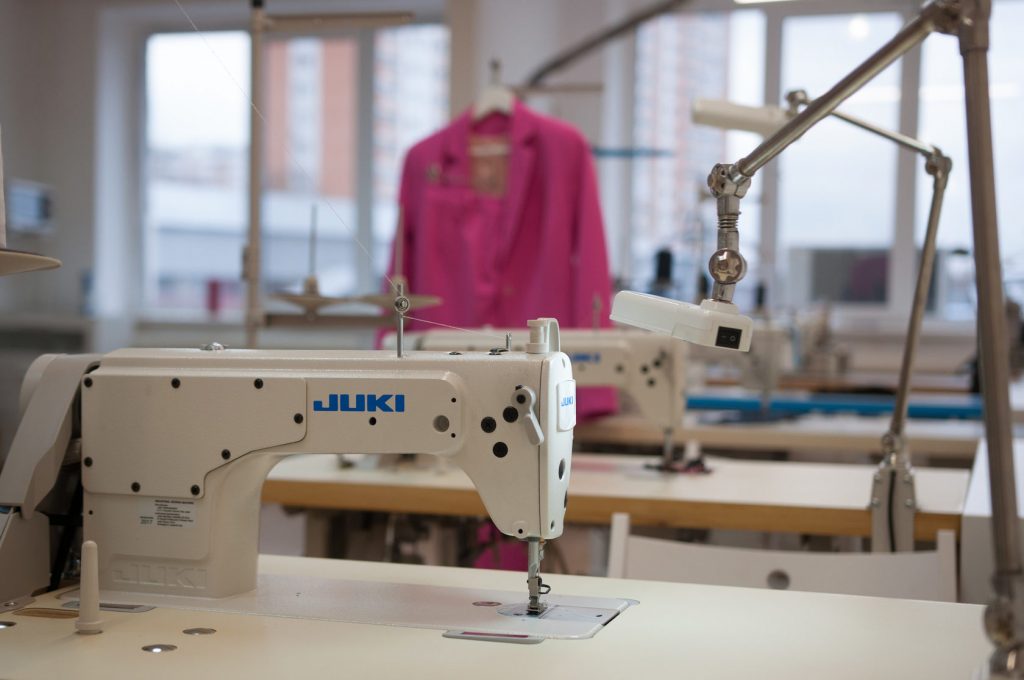
What kind of motor is best for you depends on the kind of material you’re going to be working with. Clutch motors are best for hard, thick materials like canvas and leather though they’re typically pretty loud during operation. One reason for this is because they continue running even when you’re not actively sewing. When you do step down on the pedal, you’ll immediately feel the power of this engine.
If you’re working with thin to medium weight materials, a Servo motor is a great choice, like in JUKI DDL-8700 sewing machine. They have more variety in stitch speed and some can even make decorative stitches which can come in really handy depending on your project. Servo motors aren’t quite as powerful and only operate when you step on the pedal. Because they have adjustable speed options, they’re quieter and lighter than clutch motors.
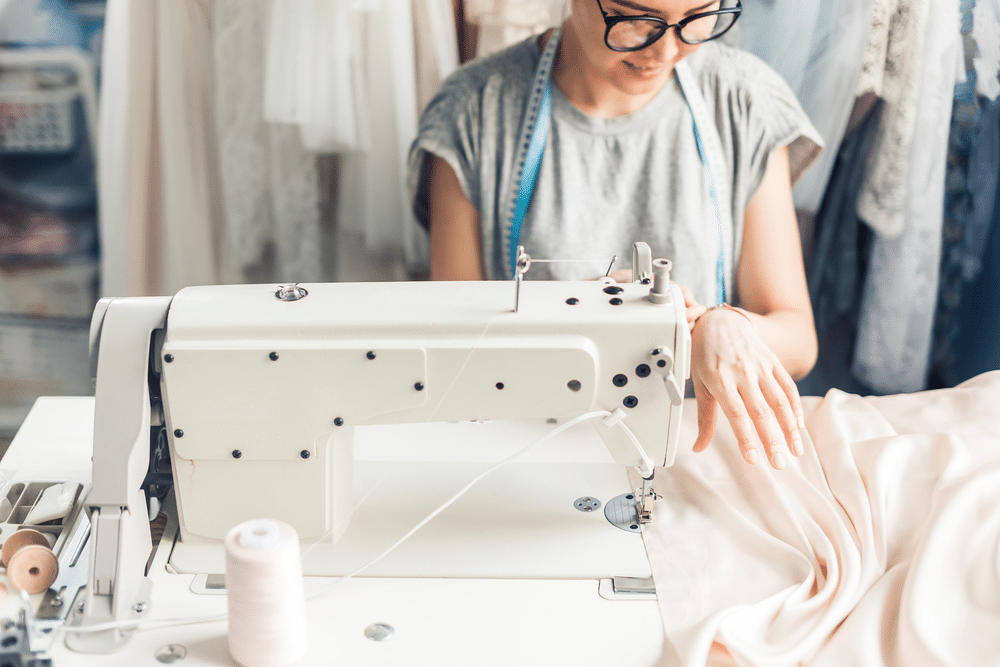
Another thing to consider is whether your home of business is powered using a 110, 220, or 440 line. Some of these machines can convert from one voltage to another but others will require additional electrical work to make sure you’re being safe. If you’re unsure, consult with the building owner or electrician just to be on the safe side.
The bed of a sewing machine is the actual work surface and, believe it or not, it’s one of the most important things to think about. Why? Because each is meant for a different kind of material. There are 3 types of beds to consider.
A post-bed sewing machine has a raised column that sits above the actual surface of the table. This platform is where the needle and fabric actually engage. Because you’re working on a smaller, raised surface, you can concentrate on details. These beds are especially useful for boots, shoes, and bags that have a lot of curves and difficult stitches.
As you might be able to guess from the name, cylinder-bed sewing machines are rounded instead of flat which makes it easier to move fabric around them for difficult, detailed stitches, especially in hard-to-reach areas. This makes them a good choice for things like footwear, caps, shirt cuffs, and bags.
Flat-bed sewing machines have the same style bed as a regular home sewing machine only on a much larger scale. This is a good choice for large projects with a lot of fabric that need to be laid flat for best results.
Because of their speed and power, industrial machines need to be regularly oiled and lubricated. There are a lot of models that are self-lubricating and continuously pump lubricant over the moving parts.
If you choose a machine that needs manual lubrication, it’s important to be very diligent about maintenance. In fact, in some cases, it’s best to avoid them altogether. If you forget to oil the machine, you could cause extensive damage that’s expensive to fix.
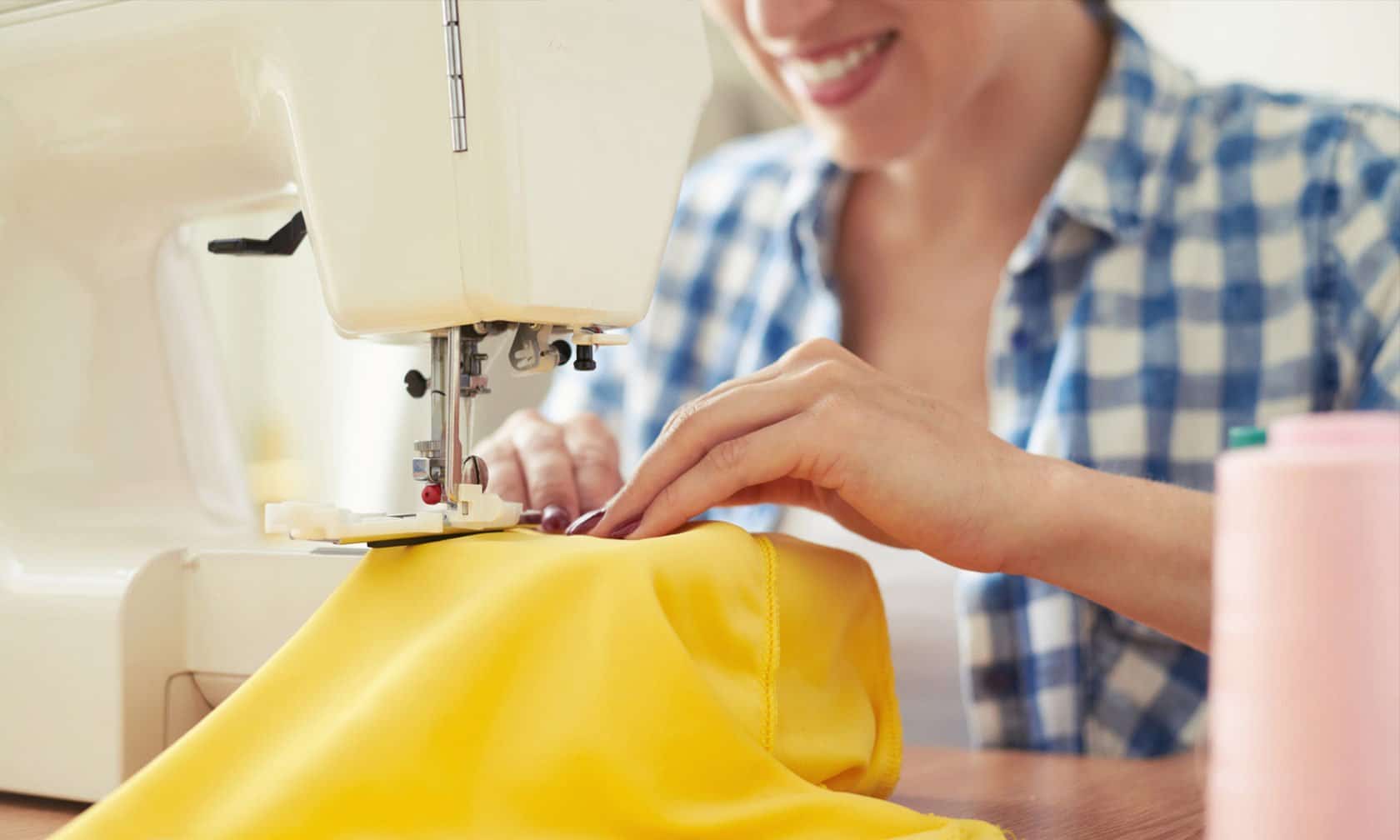
Manual feed machines have an upright motion presser foot that grips the fabric before the needle goes in and releases so that the operator can move the fabric between each stitch. This is also called free motion feeding and give the operator a lot of control. It’s good if you need a sewing machine for quilting, darning, and embroidery.
Drop feeds use something called a feed dog beneath the throat plate. The feed dog goes up through the plate with each stitch, grips the fabric to the presser foot to move it forward, then returns to its original position.
Differential feed uses dual dog feeds beneath the throat plate, one in the front and one in the rear. These can go at different speeds to create shirring or stretch the fabric as you sew.
A top feed mechanism has a presser foot that’s split into 2 different parts. One holds the fabric by the needle and the other is on the lower side and moves the fabric along according to the position of the needle.
One thing that we wanted to mention is that some of these machines may arrive with some imperfections on the table and legs. Remember, these are pieces of industrial equipment and they’re not necessarily made to be pretty. That said, any imperfections shouldn’t affect the operation of the machine.
Warranties are always important so you should be sure to look over the one that comes with your machine so you know what’s covered and, more importantly, what isn’t. Because these are industrial machines, they’re made for heavy use and most of them have decent warranties that reflect that.
It honestly depends on the machine. Be sure to look at the dimensions before you buy. If you have a lot of room in your home or factory, you can obviously get away with a larger machine than you can with limited space. There are some lightweight designs available that are easy to move, too, so you can make the most of the space you do have. One more thing, some machines are delivered to your home as assembled units and it’s important to make sure they can actually fit through your door on delivery.
Our top pick is the JUKI DDL-8700, a great all-around machine that’s meant to be used with thin to medium weight fabrics. With low vibration and low noise, this is a comfortable machine for the user and a great pick for in-home use.
If you’re looking for something that can tackle thick material, we recommend the Consew 206RB-5. It’s a good choice for leather, vinyl, upholstery, and canvas and is loved by professionals.
We also recommend the JUKI TL-2000Qi which is a really good choice for home use. It’s lightweight, portable, and really easy to use. The integrated LED lights give you a great view of your work and it includes an extension table for when you need more space to work.
There you have it, our top picks the the best industrial sewing machine. Take a good look at out tops picks and the information in our buying guide to figure out which one is the right one for you.


